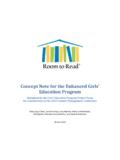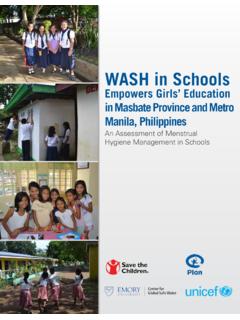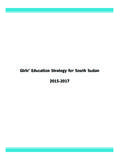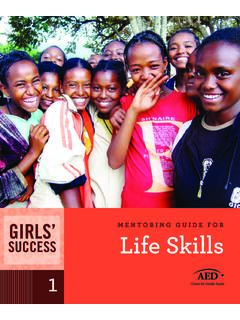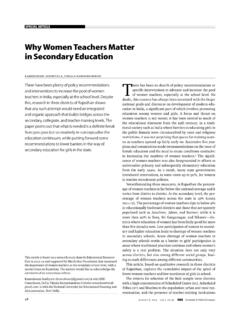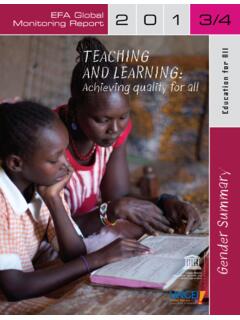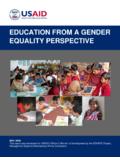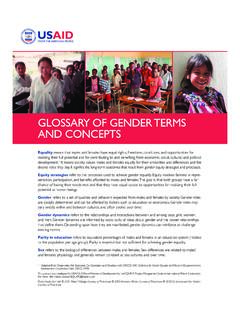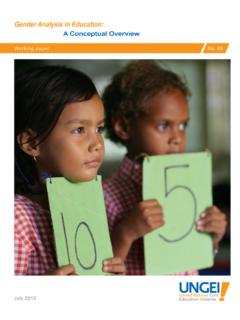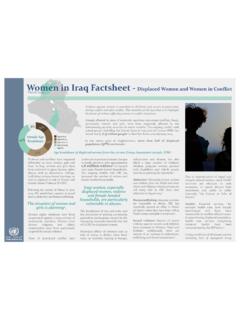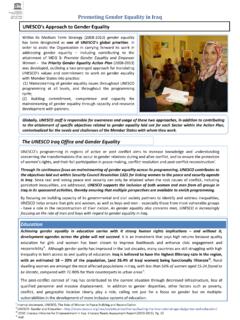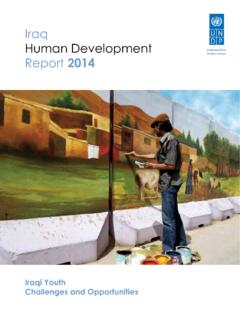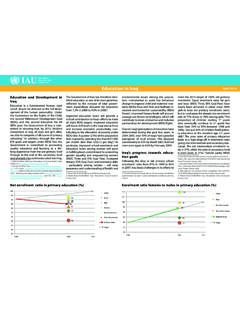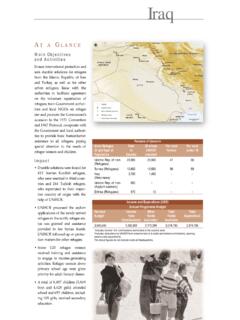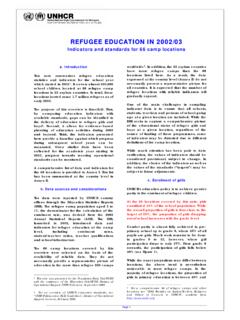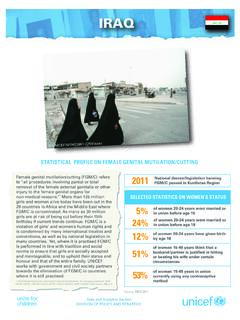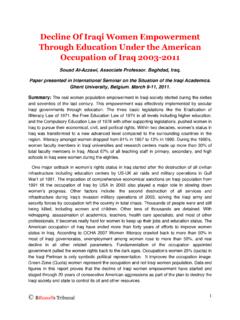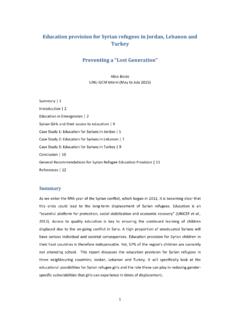Transcription of GIRLS EDUCATION IN IRAQ
1 1 GIRLS EDUCATION IN iraq 2010 2 A SITUATIONAL ANALYSIS OF GIRLS EDUCATION IN iraq With recommendations for the Government of iraq and for UNICEF iraq in their support for the Government in the development of GIRLS access to good quality EDUCATION Dr Matthew Griffiths This year s report presents a compelling argument as to why realising the full potential of Arab women is an indispensable prerequisite for development in all Arab states . The Arab Human Development Report 2005 3 Contents Page Executive Summary 4 Terminology 6 The purpose of this report 7 Methodology 7 Constraints 7 Examples of initiatives in other countries 9 Data Analysis 9 Factors contributing to the current situation
2 19 Key Findings 22 Factors from the findings that contribute to recommendations 23 Recommendations to the Government of iraq 29 Recommendations to UNICEF 31 Appendix 1 51 Appendix 2 55 Appendix 3 57 Appendix 4 60 Appendix 5 64 4 Executive Summary This report contains a situation analysis of GIRLS EDUCATION in iraq and recommendations for improving GIRLS access to good quality schooling.
3 The situation analysis is based on enrolment data provided by the Ministry of EDUCATION in iraq , a range of currently available reports and other documentation, and on the responses of 80 Iraqi GIRLS to a questionnaire relating to their own experiences of school and their views on GIRLS EDUCATION . The picture is incomplete because no data on GIRLS attendance or success rates are available and these are crucial to a full situational analysis. In iraq the overall number of children receiving primary EDUCATION has declined between 2004-05 and 2007-08 by 88,164, with no improvement in the percentage of GIRLS enrolled.
4 Gross enrolment figures provided for the academic year 2005 2005 show 5,163,440 children enrolled in primary EDUCATION . GIRLS account for of students. Figures for 2007-2008 show 5,065,276 children enrolled in primary EDUCATION , with % being GIRLS . This means that for every 100 boys enrolled in primary schools in iraq , there are just under 89 GIRLS . This under representation of GIRLS in primary school in iraq has been known for many years. The fact that there are declining numbers of GIRLS in each successive grade has also been identified analyses of the data. Analysis of the 2007 -2008 data shows the same picture.
5 In every governorate a smaller percentage of GIRLS than boys start school. There are no governorates where the number of children completing primary EDUCATION is acceptable, and it is even less acceptable for GIRLS . The current data replicate previously available data in showing a generally declining percentage of GIRLS in each successive primary school grade. Some 75% of GIRLS who start school have dropped out during, or at the end of, primary school and so do not go on to intermediate EDUCATION . Many of them will have dropped out after grade 1. When all governorates figures are combined, there are fewer GIRLS in grade 2 than in grade 1.
6 Similarly there is a national drop in the number of GIRLS between grades 5 and 6. By the first intermediate class, only 25% the number of GIRLS in grade 1 are in school; by the third intermediate class the figure is 20%. The percentage of GIRLS in primary school classes in highest in Erbil, Dohuk and Sulaimaniya. These three governorates also have the highest percentage of children in pre-school EDUCATION . In Erbil of children attend preschool provision, Dohuk and Sulaimaniya compared with, for example in Baghdad, in Kirkuk, or in Diyala. There is also a major issue with the number of children in each grade who are over age.
7 The difference between gross and net enrolment data for 2007-08 shows that 659,896 children are above the age for the grade that they are in. This represents 13% of all primary school children - more than one in every ten. Of those children, 228,829 children were still attending primary school when they were aged 13 15+. The net enrolment rate for GIRLS , as against a gross enrolment rate of This shows a significantly greater number of overage boys than GIRLS . For example, only one third of teenagers still in primary schools were GIRLS . 5 In order to increase GIRLS participation in EDUCATION , it is vital to gain an insight into why they never attend school or drop out before completing their basic EDUCATION .
8 A small scale survey of 80 Iraqi GIRLS was therefore included in this piece of work. While this is not a large or statistically valid sample, their responses provide a clear insight into many of the reasons why GIRLS do not go to school. As would be expected, parents, particularly fathers, play a major role in whether the GIRLS can attend school or not. The GIRLS refer to a range of reasons why families do not support GIRLS attending school. These include concerns about safety, family poverty, a reluctance to allow adolescent GIRLS to continue to attend school, the distance from home to school, early marriage and the need to help at home.
9 The journey to and from school presents problems caused by fast traffic, dogs or boys. GIRLS are frequently de-motivated by the behaviour of teachers who beat them, distress them and are unwilling to explain subject matter that a student does not understand. Their answers make frequent references to being beaten or insulted by teachers, and to teachers being unwilling to give explanations in lessons or support students in their learning. The GIRLS describe their schools are unwelcoming and unpleasant with too few facilities and resources. Schools are described as dirty, poorly maintained and uncomfortable, with dirty lavatories and no drinking water available.
10 Safety is an issue, particularly in areas of major instability and insecurity. The concerns about safety relate to both military conflict and civil crime such as abduction and rape. To address the issues identified, two sets of recommendations are included in this report. The first for the government and EDUCATION services in iraq , address key policy issues and their implementation; the second for the EDUCATION Section of UNICEF iraq are for consideration for inclusion in their work plan as is drawn up for the support of the provision of EDUCATION in iraq . Those for the government focus on policy development and implementation, awareness-raising, school improvement and development, pre-service and in-service teacher training, curriculum development, alternative EDUCATION strategies, and security for GIRLS travelling to and from school.
